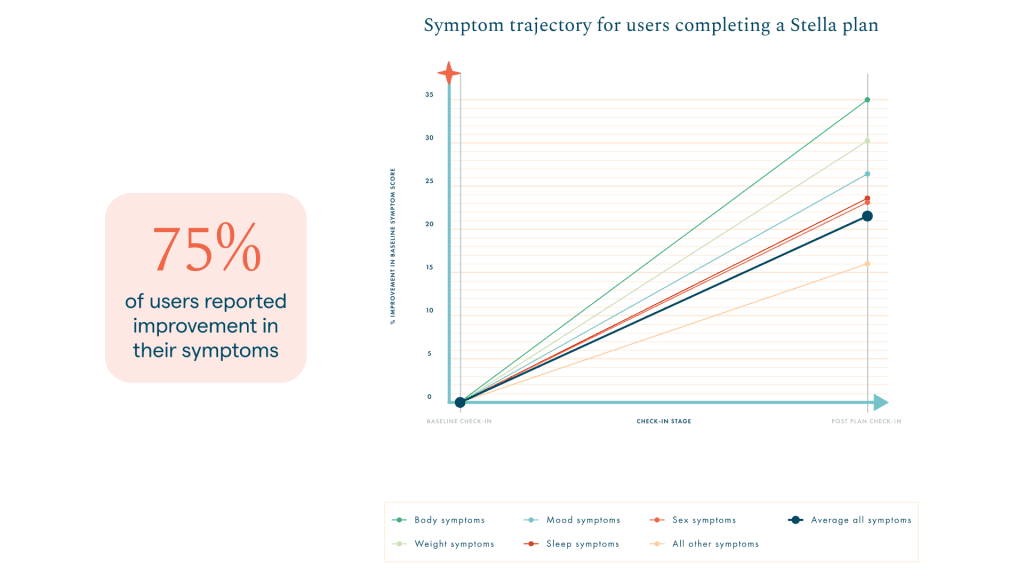The science behind Stella
Evidence base underpinning the content
The process used to develop Stella drew heavily upon the best medical evidence available. This means that the Stella team reviewed clinical research and current guidelines to choose the most effective techniques and treatments for menopause symptoms. These were then incorporated into the app.
Vira Health conducted an initial investigation of 76 Stella app users who completed multiple monthly symptom check-ins. The results indicate a statistically significant improvement between the average baseline and final symptom scores, with the majority of users reporting an improvement in their symptoms. We also observed that users who completed a plan were more likely to report an improvement in their symptoms than those who did not. These preliminary findings are currently being refined and prepared for publication in an academic journal.

Ayers, B., Mann, E., & Hunter, M. S. (2011). A randomised controlled trial of cognitive-behavioural therapy for women with problematic menopausal hot flushes: MENOS 2 trial protocol. BMJ Open, 1(1).
Ayers, B., Smith, M., Hellier, J., Mann, E., & Hunter, M. S. (2012). Effectiveness of group and self-help cognitive behavior therapy in reducing problematic menopausal hot flushes and night sweats (MENOS 2): a randomized controlled trial. Menopause, 19(7), 749-759.
Balabanovic, J., Ayers, B., & Hunter, M. S. (2013). Cognitive behaviour therapy for menopausal hot flushes and night sweats: a qualitative analysis of women’s experiences of group and self-help CBT. Behavioural and Cognitive Psychotherapy, 41(4), 441.
Barnes, C. M., Miller, J. A., & Bostock, S. (2017). Helping employees sleep well: Effects of cognitive behavioral therapy for insomnia on work outcomes. Journal of Applied Psychology, 102(1), 104.
Bostock, S., Luik, A. I., & Espie, C. A. (2016). Sleep and productivity benefits of digital cognitive behavioral therapy for insomnia: a randomized controlled trial conducted in the workplace environment. Journal of occupational and environmental medicine, 58(7), 683-689.
Hunter, M., & Smith, M. (2019). Cognitive Behaviour Therapy (CBT) for Menopausal Symptoms. Retrieved 15 April 2021, from https://thebms.org.uk/publications/tools-for-clinicians/cognitive-behaviour-therapy-cbt-menopausal-symptoms/
Couch to 5K: week by week. (2020). Retrieved 15 April 2021, from https://www.nhs.uk/live-well/exercise/couch-to-5k-week-by-week/
Currie, H. (2021). Menopause and insomnia. Retrieved 15 April 2021, from https://www.womens-health-concern.org/wp-content/uploads/2020/12/17-WHC-FACTSHEET-Menopause-and-insomnia-DEC2020.pdf
Dumoulin, C., Cacciari, L. P., & Hay‐Smith, E. J. C. (2018). Pelvic floor muscle training versus no treatment, or inactive control treatments, for urinary incontinence in women. Cochrane database of systematic reviews, (10).
Espie, C. A., Kyle, S. D., Williams, C., Ong, J. C., Douglas, N. J., Hames, P., & Brown, J. S. (2012). A randomized, placebo-controlled trial of online cognitive behavioral therapy for chronic insomnia disorder delivered via an automated media-rich web application. Sleep, 35(6), 769-781.
Fenlon, D., Maishman, T., Day, L., Nuttall, J., May, C., Ellis, M., … & Hunter, M. S. (2020). Effectiveness of nurse‐led group CBT for hot flushes and night sweats in women with breast cancer: Results of the MENOS4 randomised controlled trial. Psycho‐Oncology, 29(10), 1514-1523.
Headspace. (2021). Retrieved 15 April 2021, from https://www.england.nhs.uk/supporting-our-nhs-people/support-now/wellbeing-apps/headspace/
Hicks, J., Green, A., Anderson, K., Berger, L., Ellis, J., O’Regan, D., & Selsick, H. (2019). Expert Consensus on Minimum Standards of Practice in the use of Cognitive Behavioural Therapy for Insomnia (CBT-I) 2019 (Rep.).
How it works. Retrieved 15 April 2021, from https://www.squeezyapp.com/how-it-works/
Hamoda, H., & Moger, S. (2021). Impact of the COVID-19 pandemic on the delivery of menopause education and training.
Idris, I., Hampton, J., Moncrieff, F., & Whitman, M. (2020). Effectiveness of a digital lifestyle change program in obese and type 2 diabetes populations: Service evaluation of real-world data. JMIR diabetes, 5(1), e15189.
Information for Patients. (2021). Retrieved 15 April 2021, from https://bsug.org.uk/pages/information-for-patients/111
Insomnia | Health topics A to Z | CKS | NICE. (2021). Retrieved 15 April 2021, from https://cks.nice.org.uk/topics/insomnia/
Kim, C. (2012). Does menopause increase diabetes risk? Strategies for diabetes prevention in midlife women. Women’s Health, 8(2), 155-167.
Lee, M., Lee, H., Kim, Y., Kim, J., Cho, M., Jang, J., & Jang, H. (2018). Mobile app-based health promotion programs: a systematic review of the literature. International journal of environmental research and public health, 15(12), 2838.
Linardon, J., Cuijpers, P., Carlbring, P., Messer, M., & Fuller‐Tyszkiewicz, M. (2019). The efficacy of app‐supported smartphone interventions for mental health problems: A meta‐analysis of randomized controlled trials. World Psychiatry, 18(3), 325-336.
Liu, Y., Ma, L., Yang, X., Bie, J., Li, D., Sun, C., … & Lin, J. (2019). Menopausal hormone replacement therapy and the risk of ovarian cancer: a meta-analysis. Frontiers in endocrinology, 10, 801.
Loerinc, A. G., Meuret, A. E., Twohig, M. P., Rosenfield, D., Bluett, E. J., & Craske, M. G. (2015). Response rates for CBT for anxiety disorders: Need for standardized criteria. Clinical psychology review, 42, 72-82.
Marques, A., Stothers, L., & Macnab, A. (2010). The status of pelvic floor muscle training for women. Canadian Urological Association Journal, 4(6), 419.
Marsh, S. (2021). Women bear brunt of Covid-related work stress, UK study finds. Retrieved 15 April 2021, from https://www.theguardian.com/society/2020/oct/09/women-bear-brunt-of-covid-related-work-stress-uk-study-finds
Menopause and diet. (2019). Retrieved 15 April 2021, from https://www.bda.uk.com/resource/menopause-diet.html
Menopause at Work: Survey Results Published!. (2019). Retrieved 15 April 2021, from https://www.newsonhealth.co.uk/news/menopause-at-work-survey-results-published
Mosconi, L., Rahman, A., Diaz, I., Wu, X., Scheyer, O., Hristov, H. W., … & Brinton, R. D. (2018). Increased Alzheimer’s risk during the menopause transition: A 3-year longitudinal brain imaging study. PloS one, 13(12), e0207885.
Newson, L. (2018). Menopause and cardiovascular disease. Post reproductive health, 24(1), 44-49.
NHS Diabetes Prevention Programme (NHS DPP). Retrieved 15 April 2021, from https://www.england.nhs.uk/diabetes/diabetes-prevention/
Nonhormonal management of menopause-associated vasomotor symptoms: 2015 position statement of The North American Menopause Society. (2015). Menopause (New York, N.Y.), 22(11), 1155–1174. https://doi.org/10.1097/GME.0000000000000546
Nygaard, I. E., & Shaw, J. M. (2016). Physical activity and the pelvic floor. American journal of obstetrics and gynecology, 214(2), 164-171.
Overview – Generalised anxiety disorder in adults. (2021). Retrieved 15 April 2021, from https://www.nhs.uk/mental-health/conditions/generalised-anxiety-disorder/overview/
Overview – Ieso Digital Health – NHS. (2019). Retrieved 15 April 2021, from https://www.nhs.uk/services/trusts/overview/defaultview.aspx?id=107551
Patient Information – The Pelvic Floor Society. (2021). Retrieved 15 April 2021, from https://thepelvicfloorsociety.co.uk/patient-information/patient-information/
Penn, L., Rodrigues, A., Haste, A., Marques, M. M., Budig, K., Sainsbury, K., … & Sniehotta, F. F. (2018). NHS Diabetes Prevention Programme in England: formative evaluation of the programme in early phase implementation. BMJ open, 8(2).
Preventing excess weight gain (NG7). (2015). Retrieved 15 April 2021, from https://www.nice.org.uk/guidance/ng7/resources/preventing-excess-weight-gain-pdf-51045164485
Price, N., Dawood, R., & Jackson, S. R. (2010). Pelvic floor exercise for urinary incontinence: a systematic literature review. Maturitas, 67(4), 309-315.
Recommendations | Urinary incontinence and pelvic organ prolapse in women: management. (2019). Retrieved 19 April 2021, from https://www.nice.org.uk/guidance/ng123/chapter/Recommendations#physical-therapies
Rimmer, A. (2020). Breaking the menopause taboo: more must be done to support doctors, says BMA. BMJ: British Medical Journal (Online), 370.
Roshanaei‐Moghaddam, B., Pauly, M. C., Atkins, D. C., Baldwin, S. A., Stein, M. B., & Roy‐Byrne, P. (2011). Relative effects of CBT and pharmacotherapy in depression versus anxiety: is medication somewhat better for depression, and CBT somewhat better for anxiety?. Depression and anxiety, 28(7), 560-567.
Rurik, I., Móczár, C., Buono, N., Frese, T., Kolesnyk, P., Mahlmeister, J., … & Jancsó, Z. (2017). Early and menopausal weight gain and its relationship with the development of diabetes and hypertension. Experimental and Clinical Endocrinology & Diabetes, 125(04), 241-250.
Rymer, J., Brian, K., & Regan, L. (2019). HRT and breast cancer risk. BMJ, l5928. doi: 10.1136/bmj.l5928
The Science | Slimming World. (2021). Retrieved 15 April 2021, from https://www.slimmingworld.co.uk/the-science-behind-slimming-world
Scheyer, O., Rahman, A., Hristov, H., Berkowitz, C., Isaacson, R. S., Brinton, R. D., & Mosconi, L. (2018). Female sex and Alzheimer’s risk: the menopause connection. The journal of prevention of Alzheimer’s disease, 5(4), 225-230.
Schoeppe, S., Alley, S., Van Lippevelde, W., Bray, N. A., Williams, S. L., Duncan, M. J., & Vandelanotte, C. (2016). Efficacy of interventions that use apps to improve diet, physical activity and sedentary behaviour: a systematic review. International Journal of Behavioral Nutrition and Physical Activity, 13(1), 1-26.
Second Nature in the NHS. Retrieved 15 April 2021, from https://www.secondnature.io/nhs
Sleepio | Oxford Health NHS Foundation Trust. (2021). Retrieved 15 April 2021, from https://www.oxfordhealth.nhs.uk/apps/sleepio/
Springer, K. S., Levy, H. C., & Tolin, D. F. (2018). Remission in CBT for adult anxiety disorders: a meta-analysis. Clinical psychology review, 61, 1-8.
Start the NHS weight loss plan. (2020). Retrieved 15 April 2021, from https://www.nhs.uk/live-well/healthy-weight/start-the-nhs-weight-loss-plan/
Stephenson, G. D., & Rose, D. P. (2003). Breast cancer and obesity: an update. Nutrition and cancer, 45(1), 1-16.
What is Slimming World on Referral?. (2021). Retrieved 15 April 2021, from https://www.slimmingworld.co.uk/health/swor/what-is-swor.aspx
Your pelvic floor. (2021). Retrieved 15 April 2021, from https://www.rcog.org.uk/en/patients/tears/pelvic-floor/
Wing, R. R., Tate, D. F., Espeland, M. A., Lewis, C. E., LaRose, J. G., Gorin, A. A., … & Lang, W. (2016). Innovative self-regulation strategies to reduce weight gain in young adults: the study of novel approaches to weight gain prevention (SNAP) randomized clinical trial. JAMA internal medicine, 176(6), 755-762.
How we gather user feedback
Customer feedback is embedded into the core of our product development through user research, which is led by Ria Vaidya, a full-time user researcher within our product team.
Ria holds a BSc in Neuroscience, MSc in Global Mental Health and in International Health Management.
We run continual user testing sessions on every part of our product offering. Participant groups are formed from both current and new customers, ensuring a diversity of backgrounds. A variety of methods are used for gathering participants, including:
- Surveys
- Social media advertisement
- Canvassing customers directly that have opted-in to be contacted
- Using professional user research platforms, such as Askable.com
Studies originate from a number of sources including direct customer feedback channels, analytical product data showing points of decline in use within the experience and new products and features before they are released. Research is then analysed and prioritised within the product development cycle based on positive impact to customers and time needed for development.
One example of a research project is a series of symptom workshops we ran under support of a UKRI Healthy Aging Grant. During May and June 2022, we recruited 75 women from diverse backgrounds (over 40% non-white) in seven co-creation workshops. The research covered the app’s distinct symptom areas, including sleep, mood, hot flushes, night sweats, bladder problems, sex, weight gain and joint pain.
The learnings and feedback from the workshop fed into plan development and a new version launched in August 2022. The research led to the following changes in the app content:
- More multi-media and video content from experts
- Improved habit setting to allow for personalisation
- More stories of menopause experiences
- The ability to change plans when symptoms change
Vira is dedicated to improving accessibility for all, including the 20% of the UK population living with Disabilities. To ensure this, we collaborated with With Not For, an organisation that supports research in this area, to get feedback from women with a variety of Disabilities. The participants found the language in the app easy to understand, jargon-free and non-threatening, including the explanations of medical and technical concepts. The feedback also helped us identify areas for improvement, which is already in the design stages. We remain committed to constantly innovating and updating the app to make it easier to use for people with Disabilities.
How we continue to monitor and develop our content
Website
All of our clinical website content is medically reviewed, currently by Dr Lucy Wilkinson. We endeavor to only publish facts which are backed up by reasonable evidence, and believe in empowering our users to understand the way medical evidence works. We cite all primary sources at the end of each blog in the standard way and often within the main body copy too.
We have authorship bios for every author. Many of our authors come from a professional background and will be participating in continuous professional development, which feeds into the content they produce.
We track rewrites, publish and review dates using our content planner. Dr Wilkinson regularly reviews our content and flags any changes in research/guidance that we need to address in our content.
Our website is GDPR compliant with privacy policy and terms and conditions clearly accessible. We download our images from Adobe and follow copyright rules. We use Government Digital Service, NHS Style Guide, Guardian Style Guide and Plain English Campaign guidelines when writing content to make it accessible.
App
Content within the plans on our app is drafted by subject matter experts, reviewed by different specialists and signed off through a rigorous fact-checking process. Our experts check our content for accuracy and we update our plans if there are any research or scientific developments so information is always up-to-date.
We strive for accessibility in content design. It is important that Stella is inclusive and accessible to a wide audience, including those who are less confident in using technologies of this kind. For this reason, we have endeavored to make the app as simple and straightforward to use as possible.




